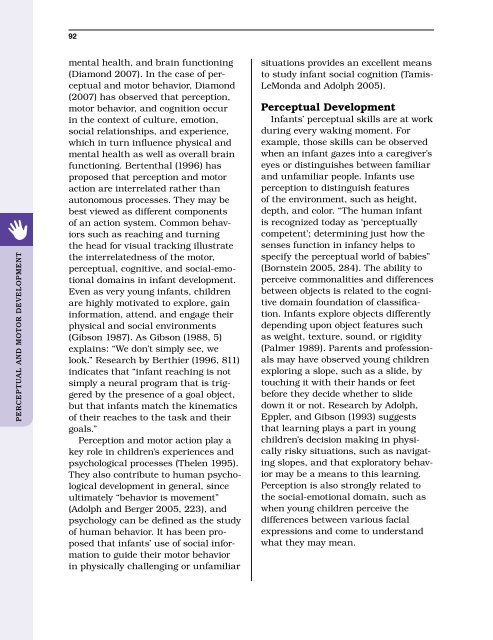Infant Toddler Learning & Development Foundations
Infant Toddler Learning & Development Foundations
Infant Toddler Learning & Development Foundations
You also want an ePaper? Increase the reach of your titles
YUMPU automatically turns print PDFs into web optimized ePapers that Google loves.
PERCEPTUAL AND MOTOR DEVELOPMENT<br />
92<br />
mental health, and brain functioning<br />
(Diamond 2007). In the case of perceptual<br />
and motor behavior, Diamond<br />
(2007) has observed that perception,<br />
motor behavior, and cognition occur<br />
in the context of culture, emotion,<br />
social relationships, and experience,<br />
which in turn influence physical and<br />
mental health as well as overall brain<br />
functioning. Bertenthal (1996) has<br />
proposed that perception and motor<br />
action are interrelated rather than<br />
autonomous processes. They may be<br />
best viewed as different components<br />
of an action system. Common behaviors<br />
such as reaching and turning<br />
the head for visual tracking illustrate<br />
the interrelatedness of the motor,<br />
perceptual, cognitive, and social-emotional<br />
domains in infant development.<br />
Even as very young infants, children<br />
are highly motivated to explore, gain<br />
information, attend, and engage their<br />
physical and social environments<br />
(Gibson 1987). As Gibson (1988, 5)<br />
explains: “We don’t simply see, we<br />
look.” Research by Berthier (1996, 811)<br />
indicates that “infant reaching is not<br />
simply a neural program that is triggered<br />
by the presence of a goal object,<br />
but that infants match the kinematics<br />
of their reaches to the task and their<br />
goals.”<br />
Perception and motor action play a<br />
key role in children’s experiences and<br />
psychological processes (Thelen 1995).<br />
They also contribute to human psychological<br />
development in general, since<br />
ultimately “behavior is movement”<br />
(Adolph and Berger 2005, 223), and<br />
psychology can be defined as the study<br />
of human behavior. It has been proposed<br />
that infants’ use of social information<br />
to guide their motor behavior<br />
in physically challenging or unfamiliar<br />
situations provides an excellent means<br />
to study infant social cognition (Tamis-<br />
LeMonda and Adolph 2005).<br />
Perceptual <strong>Development</strong><br />
<strong>Infant</strong>s’ perceptual skills are at work<br />
during every waking moment. For<br />
example, those skills can be observed<br />
when an infant gazes into a caregiver’s<br />
eyes or distinguishes between familiar<br />
and unfamiliar people. <strong>Infant</strong>s use<br />
perception to distinguish features<br />
of the environment, such as height,<br />
depth, and color. “The human infant<br />
is recognized today as ‘perceptually<br />
competent’; determining just how the<br />
senses function in infancy helps to<br />
specify the perceptual world of babies”<br />
(Bornstein 2005, 284). The ability to<br />
perceive commonalities and differences<br />
between objects is related to the cognitive<br />
domain foundation of classification.<br />
<strong>Infant</strong>s explore objects differently<br />
depending upon object features such<br />
as weight, texture, sound, or rigidity<br />
(Palmer 1989). Parents and professionals<br />
may have observed young children<br />
exploring a slope, such as a slide, by<br />
touching it with their hands or feet<br />
before they decide whether to slide<br />
down it or not. Research by Adolph,<br />
Eppler, and Gibson (1993) suggests<br />
that learning plays a part in young<br />
children’s decision making in physically<br />
risky situations, such as navigating<br />
slopes, and that exploratory behavior<br />
may be a means to this learning.<br />
Perception is also strongly related to<br />
the social-emotional domain, such as<br />
when young children perceive the<br />
differences between various facial<br />
expressions and come to understand<br />
what they may mean.
















